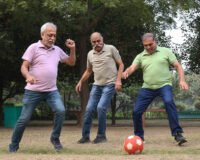Delhi NCR’s winter can be unforgiving for older adults. Along with sharp nighttime dips in temperature, there’s fog that reduces visibility, chilly winds that aggravate joint pain, and air quality that can bother lungs and eyes. Typically, the first hint of cold is felt in late November, with the coldest stretch running through December and January before easing off in February. As of late September 2025, it’s still uncertain whether this year’s winter will be harsher than usual—but that uncertainty is exactly why preparation matters. Whether you live alone or in senior living homes in Delhi NCR, a little planning in advance saves stress later. There are still about two months before the real chill sets in, which makes this the perfect window to get winter-ready.
1) Get Your Winter Wardrobe Winter-Ready: Layers, Thermals, and Comfort
Clothing is your first shield against the cold. Start with a quick check of what you have and what you need.
- Thermals first: Keep at least two good sets—top and bottom—so you can rotate and wash them without running short. If your thermals are loose, thinned out, or itchy, replace them.
- Layer up: Use simple layers you can add or remove through the day—thermals → light cardigan → fleece or wool pullover → wind-blocking jacket or shawl. Layers trap warm air and give you flexibility.
- Head, hands, and feet: Wear warm socks (ask your doctor about gentle compression if needed), easy-grip gloves, and a cap or muffler. Covering these areas reduces heat loss.
- Indoor comfort: Keep a soft fleece vest or shawl handy for rooms that feel chilly. This is easier for people with arthritis than heavy zippers or tight buttons.
- Laundry and storage: Stock mild detergent for woollens. Check for moth protection. Plan a place to air-dry clothes, since winter humidity can slow drying.
If you live in senior living homes, ask if the facility provides a winter clothing checklist, on-site laundry support, or warm drying areas. A 15-minute try-on session in October will help you find items that do not fit well anymore.
2) Heat, Hot Water, and Clean Air: Geysers, Heaters, and Air Purifiers
Safe heat and reliable hot water are essential. Make a simple service plan now.
- Geysers: Book a service before November. Ask for descaling, a thermostat check, and a safety inspection. If you stay in senior living homes, confirm the facility’s maintenance schedule and backup plans during outages.
- Room heaters: Oil-filled radiators (OFRs) give even heat and have fewer burn risks than exposed-coil heaters. Keep safe distance from curtains and bedding. Do not dry clothes on the heater. Place heaters on a stable surface.
- Power backup: Check your inverter and batteries. Cold waves and poor air days are easier to manage if your heating and air purifier can run without interruption.
- Air purifiers: Delhi’s air often worsens in late October and November. If you are exploring or already living in senior living homes in Delhi NCR, ask whether rooms and common areas have purifiers, how often filters are changed, and if indoor air is monitored. If you own a purifier, keep a spare filter and set reminders for replacement.
Request a quick winter-readiness drill at home or with your facility team. Label switches, test devices, and save maintenance numbers in large print near power points.
3) Stock Smart: Supplements and Sunshine (Vitamin D3 and Omega-3)
Shorter days mean less sun. Many people also feel stiffer joints in winter. Plan your health kit with your doctor’s advice.
- Vitamin D3: Limited sun can lower Vitamin D levels. Ask your doctor about the right dose and timing. Some seniors also need calcium; follow medical guidance.
- Omega-3 (fish oil): Omega-3 may support joint comfort and heart health. If you take blood thinners or have other conditions, check with your physician first.
- Other add-ons: Your doctor may suggest a multivitamin or magnesium. Refill all long-term medicines in advance to avoid last-minute pharmacy runs during cold spells.
- Sunshine, safely: On clear mornings, aim for 15–20 minutes of sun on the arms and face, as advised by your doctor and depending on your skin type. Even limited light can lift mood and help Vitamin D.
- Hydration matters: Cold air is dry air. Keep a thermos with warm water or herbal infusions. Dehydration can worsen fatigue, headaches, and constipation.
If you live in senior living homes, ask about pharmacy tie-ups, nurse checks, and reminders for refills or lab tests.
4) Sync Your Day with Sunrise and Sunset
As winter approaches, days get shorter. Early mornings and evenings feel much colder. Adjusting your timetable helps you stay safe and comfortable.
- Shift morning walks later: Wait until the sun is up and it is a little warmer. Fog can trap pollutants and reduce visibility.
- Finish errands earlier: Try to complete shopping and appointments before dusk. Temperatures drop quickly in the evening.
- Indoor options: On poor-air or very cold days, replace park walks with indoor movement—hallway strolls, gentle chair yoga, or light stretches cleared by your physiotherapist.
- Buddy system: If you live alone, share your walk time with a neighbor or family member. In senior living homes, join group walks or supervised sessions. They are safer and more motivating.
- Light your path: Shorter days mean darker corridors earlier. Use night lights, keep a torch charged, and check your glasses prescription.
Write your “winter timings” for walks, meals, and medicines on a sticky note. Place it where you can see it. A simple routine reduces daily decision fatigue.
5) Stay Weather-Aware: Don’t Get Caught Off Guard
The monsoon of 2025 brought heavy rain to Delhi. Many people were surprised by sudden water-logging and disruption. That experience is a reminder: seasonal shifts can be unpredictable. Heading into winter, build a one-minute daily habit.
- Check the forecast: Use the IMD app or Google Weather to note daytime highs, nighttime lows, and any fog or cold-wave alerts.
- Watch air quality: AQI matters as much as temperature in Delhi’s winter. On poor-AQI days, move activities indoors. Use your purifier as recommended. If you must step out, consider a well-fitting mask.
- Make a “winter kit”: Keep a compact umbrella, non-slip shoes, warm socks, a charged power bank, a small torch, cough-and-cold basics as prescribed, and a large-print emergency contact list near the door.
- Appliance checklist: Tape a short safety card near the heater and geyser—safe distance from fabrics, correct thermostat settings, and emergency numbers.
- Community alerts: If you are evaluating senior living homes in Delhi NCR, ask how the management shares advisories (WhatsApp groups, public address systems, floor wardens) and whether they plan health camps during the worst air weeks.
Consistency is key. A quick daily check helps you plan walks, chores, and visits without stress.
Bonus Essentials: Health, Home, and Food
- Doctor check-in: If you have asthma, COPD, heart disease, diabetes, or arthritis, book a pre-winter appointment in October. Review inhaler technique, ask about flu and pneumonia shots if relevant, and confirm any dose changes for the season.
- Home safety: Seal window drafts with weather strips. Add non-slip mats near bathrooms. Clear walkways of clutter. If you live in senior living homes, request a room safety audit that covers heater placement and emergency call buttons.
- Simple winter meals: Plan warm, easy dishes—soups, dals, seasonal greens, protein-rich snacks (eggs, paneer, legumes), and omega-3 sources (fish, walnuts, flaxseed) if your diet allows. Keep water warm so you remember to sip through the day.
The Bottom Line—and How Saral Satya Legacy (SSL) Fits In
Delhi NCR winters test everyone, and seniors most of all. The colder months usually start in late November, peak in December and January, and ease by February. We cannot say today whether 2025–26 will be harsh, but we can control our readiness. Use the next two months to:
- Audit clothing and thermals.
- Service geysers and room heaters.
- Confirm air purifiers and filter schedules if you are in senior living homes.
- Stock doctor-approved supplements like Vitamin D3 and omega-3 if needed.
- Shift your routine to match sunrise and sunset.
- Check daily weather and AQI, and plan accordingly.
At Saral Satya Legacy (SSL), we believe preparation builds independence and calm. If you or your family are exploring senior living homes in Delhi NCR, carry this checklist to your next visit. Ask about heating maintenance, indoor air quality, winter activity calendars, pharmacy tie-ups, and safety audits. A community that plans with you—before the mercury dips—helps you stay warm, active, and confident all winter long.
FAQs
1) What simple tech helps seniors track winter conditions in Delhi NCR?
Answer: Set daily alerts on your phone for temperature and AQI, and pin shortcuts to IMD/Weather and Maps. In senior living homes in Delhi NCR, request opt-in WhatsApp alerts from staff for fog, cold-wave, or power-backup notices.
2) What winter-friendly meals work for seniors with diabetes?
Answer: Build plates around soups, dals, seasonal greens, eggs/paneer, and millet/whole-wheat rotis. Limit sugary chai/snacks, sip warm water often, and space meals to avoid glucose dips.
3) How can I exercise safely when AQI is poor?
Answer: Do 10–15 minutes of indoor mobility: chair yoga, hallway laps, light resistance bands, and balance drills. In senior living homes in Delhi NCR, ask for physiotherapist-led group sessions on bad-air days.





